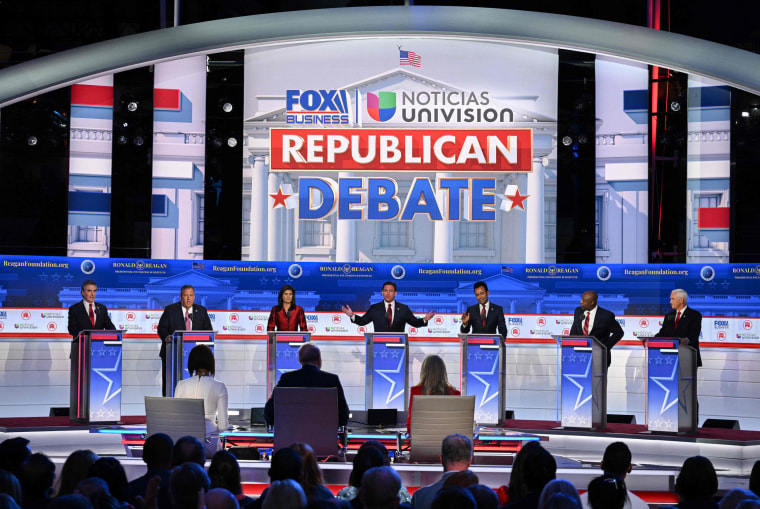Immigration was among the topics repeatedly discussed during the second Republican presidential primary debate, where seven GOP hopefuls presented their ideas to voters, attacked each other and fired a few barbs at former President Donald Trump, who leads in polls among Republican voters but has not participated in the debates.
Immigration is one of the issues that matters most to Republicans in this electoral cycle: 77% of them consider this a “very important” issue, according to a recent survey by The Economist magazine and YouGov.
During the debate, the candidates threw out some misleading numbers and made false accusations, including associating the fentanyl crisis with "open" borders and increased migration.
Here are some of the candidates' claims, which we fact-checked.
Claim: Fentanyl crisis comes from 'open border'
Sen. Tim Scott of South Carolina criticized the Biden administration for allowing the entry of migrants and assured that the southern border “is insecure” and is “wide open,” which caused “the deaths of 70,000 Americans in the last 12 months because of fentanyl.”
Associating the entry of fentanyl with the arrival of migrants is a false idea that Republicans have repeated again and again in recent months. Although the amount of fentanyl and other drugs entering the southern border has increased in recent years, experts and federal agencies have explained that the drugs mainly arrive through authorized ports of entry in private vehicles.
“Our research tells us that the vast majority of fentanyl reaches ports of entry, particularly California and Arizona,” Anne Milgram, administrator of the Drug Enforcement Administration, said during a congressional hearing.
Only 0.02% of people arrested by the Border Patrol for crossing the border illegally possessed fentanyl, according to data analyzed by the Cato Institute in 2022.
On the other hand, it is also not true that the southern border is "wide open," as Scott claimed. Although the arrival of undocumented migrants has increased in recent months — August recorded the highest monthly number of migrant arrests by the Border Patrol so far in 2023 — there are about 20,000 Border Patrol agents guarding the border with Mexico, which is also monitored by cameras, drones and other technology — not to mention more than 700 miles of border protected by a wall and other barriers,
In addition, the new policies established by the Biden administration after Title 42 expired in May seek to make it more difficult to request asylum at the border between the U.S. and Mexico and encourage migrants to apply from their countries of origin.
How many miles of border wall did Trump build?
Former New Jersey Gov. Chris Christie said Trump “built 52 miles of wall” during his presidency.
This information is correct, but needs some context.
Although Trump promised his voters that he would build a “big border wall” and that he would force Mexico to pay for it, the truth is that only 52 miles of new primary wall were built during the four years of his administration, according to a Customs and Border Protection document accessed by the verification site PolitiFact.
As of Jan. 8, 2021, just two weeks before Trump left office, his administration had built 47 miles of primary wall, according to a CBP report. According to that report, the Trump administration also had replaced 351 miles of primary wall and 22 miles of secondary barriers that were in poor condition or had outdated designs.
The United States border with Mexico extends more than 2,000 miles. When Trump finished his four years in the White House, there were a total of 706 miles of primary barriers along the border and 70 miles of secondary barriers, according to PolitiFact.
Claim: Trump reduced illegal immigration by 90%
Former Vice President Mike Pence said during the debate that the Trump administration reduced illegal immigration and asylum abuse “by 90%.”
It's not the first time that Pence has stated this figure, but his statement is false, according to PolitiFact, which could not find evidence to directly support it.
Experts who spoke with PolitiFact explained that although the Trump administration’s policies, such as the “Remain in Mexico” program, possibly contributed to a decrease in immigration, this was not the only factor at play.
The Covid-19 pandemic caused migration to fall sharply in 2020, and one figure that is close to the 90% drop that Pence pointed out occurred in May 2019, the month with the highest number of apprehensions during the Trump administration, and in April 2020, the month with the lowest enforcement actions during 2020, PolitiFact reported.
After that point, immigrant arrivals rose again. So much so that, according to the PolitiFact analysis, Trump’s last full month in office, December 2020, saw a 300% increase over February 2017, the first full month of his administration.
An earlier version of this story was first published in Noticias Telemundo.
